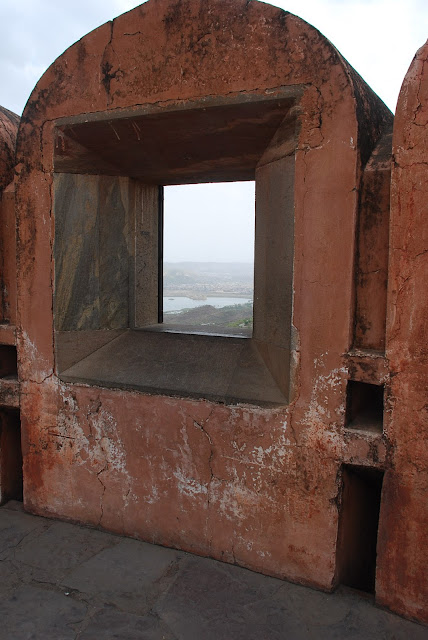Tour date: 2nd July 2009
Jaigarh Fort is situated on the cape called the Cheel ka Teela (Hill of Eagles) of the Aravalli range, overlooking the Amber Fort and the Maota Lake. The fort was built by Jai Singh II in 1726 to protect the Amber Fort and its palace complex and was named after him.
The massive Jaigarh Fort was built in 1726 and holds great appeal for military lovers. Flanked by towering gateways and watchtowers, it contains the world's largest cannon on wheels. The cannon has never been fired though, and neither has the fort been captured. As a result the fort has remained intact over its long life, and is very well preserved. In fact, it's one of the best-preserved military structures of medieval India. Jaigarh doesn't have the delicate interiors of Amber Fort, and therefore appears as a real fortress. You may want to climb the Diwa Burj watchtower to get an excellent view over the plains, like I did.
Jaigarh Fort is situated on the cape called the Cheel ka Teela (Hill of Eagles) of the Aravalli range, overlooking the Amber Fort and the Maota Lake. The fort was built by Jai Singh II in 1726 to protect the Amber Fort and its palace complex and was named after him.
Jaigarh Fort is located not far from the Amber Fort and connected through a secret tunnel in north of Jaipur. It is within a walking distance of Amber Fort but you must physically fit and ready for the adventure to do that. I went there from Amber palace by car. An entry cost is only Rs50 and the fort is open from 9am to 4.30pm daily.
The fort, rugged and similar in structural design to the Amber Fort, is also known as Victory Fort. It has a length of 3 kilometres along the north-south direction and a width of 1 kilometre (0.62 mi). The fort features a cannon named "Jaivana", which was manufactured in the fort precincts and was then the world's largest cannon on wheels. The palace complex (Laxmi Vilas, Lalit Mandir, Vilas Mandir and Aram Mandir) located within the fort has a well-tended garden where the royal family resided, the Shubhat Niwas (an assembly hall of the warriors), an armoury and a museum. Jaigarh Fort and Amber Fort are connected by subterranean passages and considered as one complex.
During the reign of the Mughal Emperor, Shah Jahan, Jaigarh Fort, which is located 150 miles south-west of Delhi, became one of the worlds most efficient Cannon foundry mainly due to the abundance of iron ore mines in the vicinity of the fort. The cannon foundry of the Jaigarh Fort had a massive wind-tunnel that sucked air from the high mountains into its furnace creating temperatures as high as 2400degrees Fahrenheit . The heated air would melt the metal. The liquid molten metal would fill a reservoir chamber and into a cannon mold in the casting pit. Most of those Cannons were massive mostly 16 ft long and had to be prepared within a single day. The Rajput also built a large ingenious mechanical device that had a precision gear system driven by four pairs of oxen, the device was used for hollowing out the Cannon barrels.
When the Mughal war of succession broke out in the year 1658, Dara Shikoh secured the Cannon outpost of Jaigarh Fort until he was defeated and executed by his younger brother Aurangzeb. Later however, the Mughal Emperor, Muhammad Shah appointed Jai Singh II as the official Mughal Governor of Jaigarh Fort. Ultimately Jai Singh II is known to have molded the great Jaivana Cannon by utilizing the important foundry and devices inside Jaigarh Fort.
The fort was very quite at the time of my visit, maybe it was quite after all due to no occupants, no life beside natures and animals of the abandon place.
















No comments:
Post a Comment